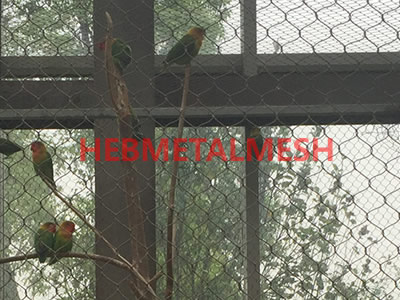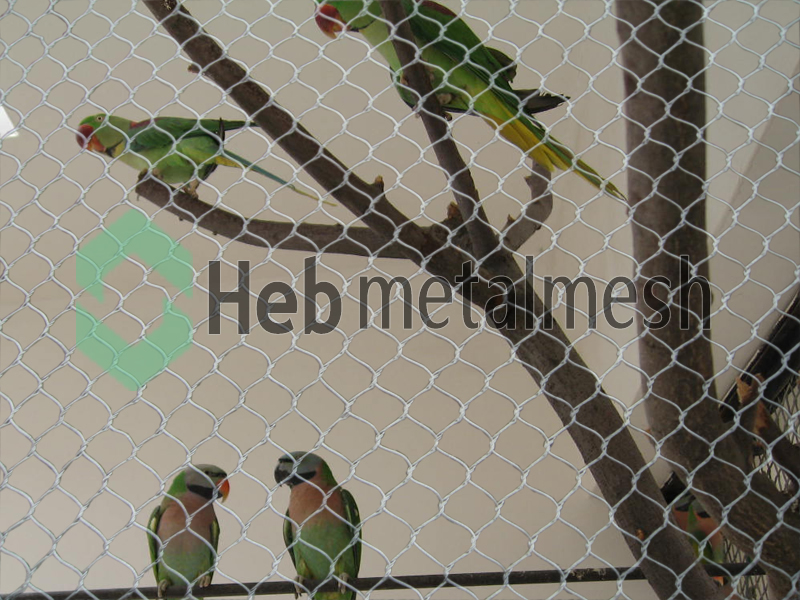As a bird lover, it is always a priority to ensure their safety and security. One of the best ways to do this is to install aviary netting. Aviary netting provides a protective barrier that keeps predators away from your birds, and it can also help to prevent your birds from escaping. In this article, we will discuss the benefits of using aviary netting, the types of netting available, factors to consider when choosing aviary netting, and tips for installation and maintenance.

Benefits of Using Aviary Netting
Aviary netting is an essential tool for any bird lover who wants to keep their birds safe from predators. The netting is designed to keep birds inside the aviary while keeping predators out. Aviary netting can also help to prevent birds from escaping, which is especially important for those who keep birds as pets. Aviary netting provides a safe environment for birds to live and play, allowing them to enjoy the outdoors without the risk of danger.
Another benefit of aviary netting is that it provides protection from the elements. The netting can protect birds from harsh weather conditions such as wind, rain, and snow. It also provides shade from the sun, which can be beneficial for birds that are sensitive to heat.
Types of Aviary Netting
There are several types of aviary netting available on the market. The most common type of netting is made from nylon or polyethylene. These materials are durable, lightweight, and resistant to UV rays. They are also easy to install and maintain.
Another type of aviary netting is made from stainless steel. This type of netting is more durable than nylon or polyethylene and can withstand harsh weather conditions. Stainless steel netting is also more resistant to chewing and scratching, which can be a problem with other types of netting.
Factors to Consider when Choosing Aviary Netting
When choosing aviary netting, there are several factors to consider. The first factor is the size of the mesh. The mesh size should be small enough to prevent predators from entering the aviary, but large enough to allow birds to fly freely. The mesh should also be strong enough to withstand wind and other weather conditions.
Another factor to consider is the material of the netting. Nylon and polyethylene are the most common materials used for aviary netting, but stainless steel is also an option. The material you choose will depend on your specific needs and budget.
Finally, consider the color of the netting. Dark colored netting is less visible and can blend in with the surrounding environment, making it less noticeable to predators. Light-colored netting is more visible, but it can also reflect heat and light, making it more comfortable for birds.
Installation of Aviary Netting
Installing aviary netting can be a daunting task, but it is essential for the safety of your birds. The first step is to measure the area where the netting will be installed. You will need to calculate the length and width of the area to determine the amount of netting you will need.
Next, you will need to install support poles or posts to anchor the netting. The poles should be sturdy and secured firmly in the ground. Once the poles are in place, you can attach the netting to them.
Finally, you will need to secure the netting to the poles using ties or clips. Make sure that the netting is taut and free of any wrinkles or gaps.
Maintenance of Aviary Netting
Maintaining aviary netting is essential to ensure its longevity and effectiveness. Regular checks should be made to ensure that the netting is free of any holes or tears. Any damage should be repaired immediately to prevent predators from entering the aviary.

Cleaning the netting is also important to prevent the buildup of dirt and debris. The netting can be cleaned using a mild detergent and water. Rinse the netting thoroughly with clean water and allow it to dry completely before reattaching it to the support poles.
Netting for Bird Cages
In addition to aviary netting, bird cage mesh is also an option for bird lovers who want to keep their birds safe. Bird cage mesh is designed to be installed around the perimeter of a bird cage to prevent birds from escaping and predators from entering.
Types of Bird Cage Mesh
There are several types of bird cage mesh available on the market. The most common type is made from stainless steel, which is durable and long-lasting. Stainless steel mesh is also resistant to chewing and scratching, which can be a problem with other types of mesh.
Another type of bird cage mesh is made from nylon or polyethylene. These materials are lightweight and easy to install, but they are not as durable as stainless steel.
Benefits of Using Bird Cage Mesh
Bird cage mesh provides a safe and secure environment for birds to live and play. It prevents birds from escaping and predators from entering, ensuring the safety of your feathered friends. Bird cage mesh also allows for better ventilation and air circulation, which is important for the health and wellbeing of birds.
Factors to Consider when Choosing Bird Cage Mesh
When choosing bird cage mesh, consider the size of the mesh. The mesh should be small enough to prevent birds from escaping, but large enough to allow for good air circulation. The material of the mesh is also important. Stainless steel is the most durable option, but nylon or polyethylene can be a more affordable option.
Installation and Maintenance of Bird Cage Mesh
Installing bird cage mesh is similar to installing aviary netting. Measure the perimeter of the bird cage and calculate the amount of mesh you will need. Install support poles or posts to anchor the mesh, and secure the mesh to the poles using ties or clips. Regularly check the mesh for any damage and clean it as needed.
Conclusion and Recommendations for Choosing the Right Netting for Your Aviary or Bird Cage
In conclusion, aviary netting and bird cage mesh are essential tools for bird lovers who want to keep their feathered friends safe and secure. When choosing netting, consider the size of the mesh, the material, and the color. Make sure to install the netting properly and regularly maintain it to ensure its effectiveness.
If you are unsure which netting is right for your aviary or bird cage, consult with a professional. They can help you choose the best netting for your specific needs and provide installation and maintenance services.
CTA: Protect your birds today with high-quality aviary netting or bird cage mesh. Contact us to learn more about our products and services.
Series zoo mesh for birds
| Item ID | Mesh Details | Material |
|---|---|---|
| HM1220 | 3/4″ x 3/4″ x 3/64″ | SS304/316 |
| HM1225 | 1″ x 1″ x 3/64″ | SS304/316 |
| HM1238 | 1.5″ x 1.5″ x 3/64″ | SS304/316 |
| HM1250 | 2″ x 2″ x 3/64″ | SS304/316 |
| HM1625 | 1″ x 1″ x 1/16″ | SS304/316 |
| HM1638 | 1.5″ x 1.5″ x 1/16″ | SS304/316 |
| HM1650 | 2″ x 2″ x 1/16″ | SS304/316 |
| HM2038 | 1.5″ x 1.5″ x 5/64″ | SS304/316 |
| HM2050 | 2″ x 2″ x 5/64″ | SS304/316 |
| HM2438 | 1.5″ x 1.5″ x 3/32″ | SS304/316 |
| HM2450 | 2″ x 2″ x 3/32″ | SS304/316 |
| HM3250 | 2″ x 2″ x 1/8″ | SS304/316 |
| HM3276 | 3″ x 3″ x 1/8″ | SS304/316 |

